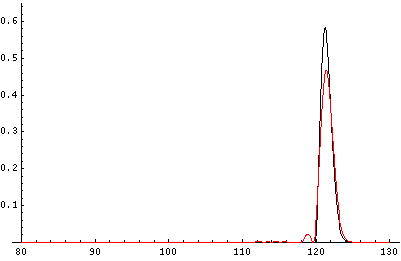
The game then is a version of Fourier analysis: producing a sum-of-eigenfunctions that adds up to a given function. Orthogonality is what makes this easy; in particular, that our energy eigenfunctions are mutually orthogonal.
Our normalized energy eigenfunctions are displaced Airy functions:

These eigenfunctions are orthogonal:

So if we try to express a given function f(z') in terms of a sum of these functions:

orthogonality allows us to solve for the bn:

In this particular example, I choose f(z') to have the shape of the ground state, but with the whole function moved over. Of course, we can't sum all the terms of the infinite sum. I've limited the sum to the 15 eigenfunctions nearest the E'=122.2 eigenfunction. Thus the sum using these 15 bn does not exactly equal the initial f(z'). The below plot displays (in black) f(z') and (in red) the sum using these 15 bn.

The missing terms would contribute only 5% additional probability, so it's a fair approximation. To see how this probability lump moves with time, we need only use the time dependence of the energy eigenfunctions:

The previous page shows the results: the lump of probability moves just like a classical particle (with broadening of the lump caused by Heisenberg-required uncertainty in initial velocity).